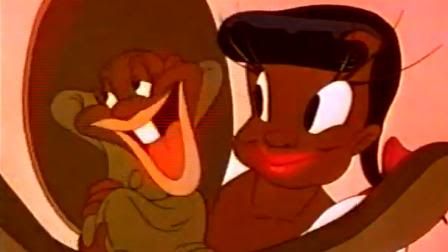
Coal Black and de Sebben Dwarfs (working title: So White and de Sebben Dwarfs) is a Merrie Melodies animated cartoon directed by Bob Clampett, produced by Leon Schlesinger Productions, and released to theatres on January 16, 1943 by Warner Bros. Pictures and The Vitaphone Corporation. The film is notable for being an all-black parody of the Brothers Grimm fairy tale Snow White, known to its audience from the popular 1937 Walt Disney animated feature Snow White and the Seven Dwarfs. The stylistic portrayal of the characters, however, is an example of darky iconography (see blackface), which was widely accepted in American society at the time. As such, it is one of the most controversial cartoons in the classic Warner Bros. library, has been rarely seen on television, and (because it is one of the Censored Eleven; see below) has never been officially released on home video. However, it is often named as one of the best cartoons ever made,[1] in part for its African-American-inspired jazz and swing music, and is considered one of Clampett's masterpieces.

In this version of the story, all of the characters are African American, and speak all of their dialogue in rhyme. The story is set during World War II in the United States, and the original tale's fairy tale wholesomeness is replaced in this film by a hot jazz mentality and sexual overtones. Several scenes unique to Disney's film version of Snow White, such as the wishing-well sequence, the forest full of staring eyes, and the awakening kiss, are directly parodied in this film. The film was intended to have been named So White and de Sebben Dwarfs, which producer Leon Schlesinger thought was too close to the original film's actual title, and had changed to Coal Black and De Sebben Dwarfs.
Clampett intended Coal Black as both a parody of Snow White and a dedication to the all-black jazz musical films popular in the early 1940s (i.e. Cabin in the Sky, Stormy Weather, etc.). In fact, the idea to produce Coal Black came to Clampett after he saw Duke Ellington's 1941 musical revue Jump for Joy, and Ellington and the cast suggested Clampett make a black musical cartoon. The Clampett unit made a couple of field trips to Club Alabam, a Los Angeles area black club, to get a feel for the music and the dancing, and Clampett cast popular radio actors as the voices of his main three characters. The main character, So White, is voiced by Vivian Dandridge, sister of Dorothy. Their mother, Ruby Dandridge, voices the Wicked Queen. Leo Watson is the voice of "Prince Chawmin'". The other characters, including the Sebben Dwarfs, are voiced by standard Warner voice artist Mel Blanc.

Originally, Clampett wanted an all-black band to score the cartoon, the same way Max and Dave Fleischer had Cab Calloway and His Orchestra score the Betty Boop cartoons Minnie the Moocher, The Old Man of the Mountain, and their own version of Snow White. However, Schlesinger refused, and the black band Clampett had hired, Eddie Beals and His Orchestra, only recorded the music for the final kiss sequence. The rest of the film was scored, as was standard for Warner cartoons, by Carl W. Stalling.
Coal Black and de Sebben Dwarfs by totenkopf999

it's a shame Coal Black did not exist only in this cartoon. She is so beautiful. Nowadays she would have been free from all theses stereotypes !
ReplyDeletehttp://betty-boop-world.blogspot.fr
I use Coal Black (or "Soe White" in my Intro to Lit class as an example of changing cultural assumptions which also affect portrayals of ethnic individuals in literature. This leads especially to talk about Huckleberry Finn and Uncle Tom's Cabin. One aspect that I pursue is the difference between stereotypes and cultural satire. Switch-blades and black-face are white visions of black-culture, but what about dance hall lingo and jazz music (which Clampet loved)? Those actually exist in Afro-american culture don't they? When Richard Pryer comments on the differences between what he has seen of white funerals and black funerals (one is characterized by quiet "pinned-down" sniffles and the other by wails of grief) is he not actually talking about organic cultural differences rather than racist views?
ReplyDeleteThat sounds like a fascinating class. Do you have any videos of your class, or your syllabus, or your reading list? Have you written any cultural criticisms that are published or available on the internet?
Delete